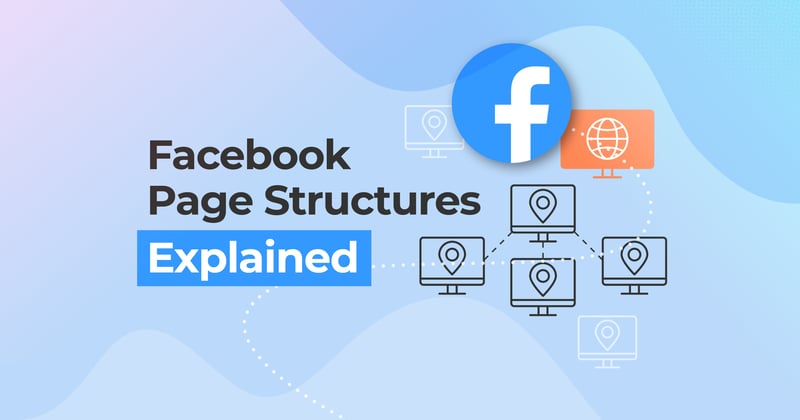Managing a Facebook presence for a business with dozens or hundreds of locations can quickly get complicated. Should every store have its own Facebook Page? Or is it better to connect them under one brand page with child pages? And what about global brands, how does Facebook handle country-level structures? This guide breaks down the three main Facebook Page structures available to multi-location brands:
- Individual Pages
- Brand Page + Location Pages
- Global Page Setup
We’ll look at how each works, when they make the most sense, and what trade-offs to expect.

1. Individual Pages
How it works:
Each location has its own standalone Facebook Page. These pages are completely independent: there’s no structural link between them, and each one is managed separately.
Best for:
Franchises or small chains where each location operates autonomously, or where local managers handle their own content, reviews, and responses.
Considerations:
- Management overhead: Content must be posted manually to each page. Admin roles and access must be set up individually.
- Brand consistency: Harder to control brand tone, naming conventions, and user experience across all pages.
- Discoverability: Users must find each page separately as there’s no centralized listing of all locations.
- Address visibility: You can choose to hide or show addresses for each page.
2. Brand Page + Location Pages (Main + Child Pages)
How it works:
You create one main brand page and then link individual location pages to it as child pages. All pages share the brand identity but display local-specific info like address, hours, and contact details.
Best for:
Mid-size to large businesses that want centralized control but still need to display local information for each store.
Considerations:
- Efficiency: Content posted to the main brand page can be mirrored to location pages. Review replies and page roles can be managed more efficiently.
- Consistency: Page names follow a standardized format (e.g., “Brand (Stockholm)”), and location pages must show an address.
- Discoverability: Customers can find the main brand page and browse linked locations on the main page.
- Limitations: Page likes aren’t centralized, so each location page collects its own followers and engagement.
Local marketing made easy. Sign-up to our Monthly Newsletter below.
3. Global Page Structure
How it works:
Facebook’s Global Pages structure is designed for international brands. It automatically redirects users to the country-specific version of a brand page based on language, location, or browser settings.
Best for:
Large international businesses that want to serve tailored content per region while maintaining a unified global presence (e.g., Starbucks, H&M).
Considerations:
- User experience: Customers are automatically shown the most relevant country page.
- Localized control: Each country page can manage its own content, language, and audience targeting.
- Setup complexity: Setting up a Global Page requires working directly with Meta as it’s not done through standard tools or platforms.
- Page roles: Similar to Brand + Location structure, admins can manage pages globally or regionally.
- Limitations: Page likes aren’t centralized, so each location page collects its own followers and engagement.
How PinMeTo Supports Multi-Location Brands on Facebook
While Facebook offers flexibility, managing dozens or hundreds of pages can quickly get overwhelming, especially when each location needs accurate info, localized posts, and fast review responses.
Local marketing automation tools like PinMeTo help brands manage their Facebook presence more efficiently. Here’s how:
- Simplified Location Page Setup: Facebook’s page structures can be tricky to configure, especially when linking existing pages or merging unofficial ones. PinMeTo’s team supports this setup and helps ensure your page hierarchy is clean, compliant, and consistent from day one.
- Centralized Content & Brand Control: Publish posts to all your Facebook location pages at once, or target specific regions, while keeping brand tone and visuals aligned across the board.
- Unified Review Management: Respond to reviews and messages across all Facebook pages from a single inbox, saving hours of manual work and improving your response rate.
- Reliable Integrations Across Platforms: Keep your location data synchronized not only on Meta, but also Google, Apple, Bing, and more, ensuring accuracy wherever people search.
Whether you’re just starting with one page or managing hundreds across countries, PinMeTo simplifies multi-location Facebook management so your teams can focus on visibility and customer experience.
To Sum Up
Choosing the right Facebook Page structure is about balance between control and flexibility, centralization and localization. There’s no one-size-fits-all answer, but understanding your options helps you avoid painful migrations down the road. For most growing multi-location brands, the Brand + Location Pages structure hits the sweet spot: easier to manage, more discoverable, and flexible enough to grow with you.
Looking for ways to level up your local visibility?
Give us an overview of your business below and our experts will schedule a live demo with you.
Lily Adamyan, July 17
.png?width=3333&height=7917&name=FB-Setup-Differences%20(1).png)


.png?width=600&name=Apple%20Maps%20Web%20Thumbnail%20(1).png)
